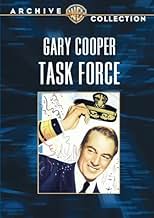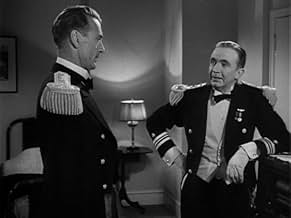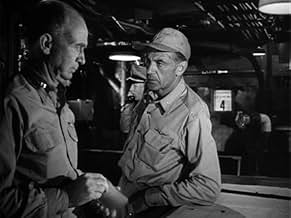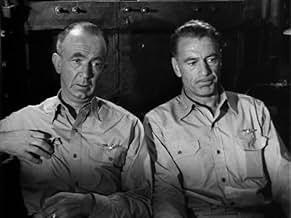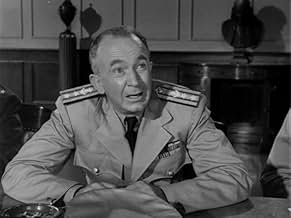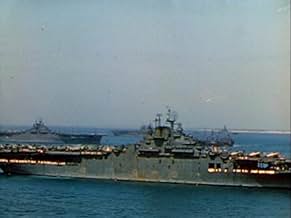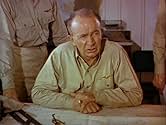Ajouter une intrigue dans votre langueAs he is retiring, Jonathan L. Scott "Scotty" reminisces about his long Navy career and the development of the role of the aircraft carrier from the early 20s.As he is retiring, Jonathan L. Scott "Scotty" reminisces about his long Navy career and the development of the role of the aircraft carrier from the early 20s.As he is retiring, Jonathan L. Scott "Scotty" reminisces about his long Navy career and the development of the role of the aircraft carrier from the early 20s.
- Réalisation
- Scénario
- Casting principal
- Récompenses
- 3 victoires au total
- Pilot
- (non crédité)
- Pilot
- (non crédité)
- Pilot
- (non crédité)
- Ames' Attache
- (non crédité)
Avis à la une
The picture begins in 1922 when carriers were just getting started. The picture is at its best when we see the early American isolationism that evolved after World War 1.
Gary Cooper is in fine form as the pilot who is banished to Panama for stepping on too many toes for his pro-carrier beliefs. Jane Wyatt plays a woman who loses her husband during a practice run and marries Cooper later on.
The last 20 minutes of the film is shown in Technicolor under the admirable direction of Natalie Kalmus, a person used Technicolor so vibrantly in the films of the late 1930s and 1940s as well. The battle scenes are quite authentic and this picture serves well as a tribute to our fighting forces during World War 11.
Later, when WWII arrives, the film is much more of an action flick and gives a very competent overview of the war in the Pacific. While this did employ a lot of stock footage, it was unusual in that most all of the footage was used correctly. Unlike the ridiculously historically inaccurate film, MIDWAY (1976), TASK FORCE made sure to use clips that were accurate--featuring the correct model planes for each segment of the war (whereas in MIDWAY, they often showed planes that weren't even in the naval arsenal until well after the battle as well as had dive bombers magically turn into fighter planes in mid-flight due to horrid editing blunders).
This film really has widely different appeal depending on your perspective. If you are a history teacher and airplane nut like me, then it earns a 9 because it does a really good job of conveying the history of the American aircraft carriers from its inception in the early 1920s through WWII. However, if you are not, then you might find the film a bit cold (as it often focuses more on events than people towards the middle to the end of the film) and it might seem a bit confusing if you aren't familiar with the history of these great ships.
With Pearl Harbor, Cooper's "Scottie" Scott is thrown into battle against an enemy that is much better prepared for air combat, and with the aid and leadership of his father figure, Walter Brennan, he (as metaphor) gains the recognition and ultimate victory he deserves.
I read somewhere that Gary Cooper surrendered his chance at ultra-stardom when he made certain decisions about parts that robbed his film persona of the sort of sex appeal that would have guaranteed his place as a film star/sex symbol. The reviewer said something about Cooper being more of a big brother than a lover.
I don't know if all this is true, but Cooper's image of being a friendly, decent, human hero is clearly seen in Task Force. He--and Brennan--carry this movie. The chemistry Coop has with his audience and his on-screen friend and C.O., Brennan, puts real blood and muscle into a movie that at times gets a bit too documentarian. Add in a sweet, loving performance by Jane Wyatt as the graceful and gracious military wife and you have a really human movie that works as history lesson, war film, political essay, and love story.
Finally, what I love about this film is its innate patriotism. There simply is no questioning of America's place and motive in the years leading up to and during the Second World War. We were a democracy threatened by tyranny. We were unprepared for war because we despised it so very much; once confronted, we prevailed. The stock footage of Cooper's carrier (in real life, the badly damaged USS Franklin) arriving at New York with her flight deck and upper hull twisted into scrap metal by Japanese explosives is startling, a metaphor for the cost of not being prepared with the sort of cutting-edge technology, training, and will that might have reduced the bloodiness of the war or prevented it all together.
For today's fans if one wants to see where Tom Cruise and the gang from Top Gun all got their start, take a look at Task Force. The idea of a floating flattop ship from where airplanes could take off and land was one that was scoffed at post World War I. Pilots didn't have the skills yet for that. What Task Force shows is Gary Cooper and a whole bunch of other people who believed in an idea living and dying to prove that idea.
Task Force was memorable in the career of Gary Cooper for two other reasons. It was the first film he did after leaving his original studio, Paramount, at Warner Brothers where he worked for about five years. It was also the last film he did with good friend Walter Brennan. They made eight joint film appearances, including some memorable ones in The Westerner and Sergeant York where they got Oscars, Brennan for The Westerner and Cooper for Sergeant York.
Jane Wyatt is Cooper's leading lady, playing the part of the faithful wife where if this had been made at MGM, June Allyson would have had the part. She's the widow of one of Cooper's early Navy flier friends who is killed trying to land on a new aircraft carrier.
Director Delmar Daves made good use of actual combat footage both black and white and in the last 15 minutes color. Lent a real air of authenticity to what we were viewing. Look for some good supporting performances from Brennan, Wayne Morris, Bruce Bennett and the best being an obtuse United States Senator played by Stanley Ridges.
The final shot of the film shows Cooper now in civilian attire with jets passing overhead. That was a whole new skill that had to be learned by the next generation of Top Guns. Very graphically demonstrated in The Bridges at Toko-Ri.
I'd like to think that Tom Cruise and the rest of the cast of Top Gun saw those two films and realized the great heritage they were now going to portray.
Le saviez-vous
- AnecdotesWayne Morris who portrayed Lt.McKinney was the only actor in the cast who had actual combat experience as a carrier pilot in WWII. As a fighter pilot, Morris shot down seven enemy planes and contributed to the sinking of five enemy ships. He was awarded four Distinguished Flying Crosses and two Air Medals. He was the only combat "ace" of all the Hollywood actors who went to war.
- GaffesDuring the attack sequence on the Japanese carriers at Midway, the film shows the dive bombers striking first. Actually, it was the torpedo bombers that attacked first. This was caused by missed communications between the torpedo planes and the fighter cover. It was supposed to be a coordinated high-low attack. Almost every torpedo plane was shot down. No torpedoes made hits. While a tragic accident, the torpedo planes drew the Japanese fighter cover down to wave top height. When the U.S. fighters and dive bombers arrived there were very few Japanese fighters to intercept them.
- Citations
Pete Richard: The disarmament conference is over. They've sunk the fleet. The Missouri, the South Dakota, the Maine, the Virginia, Nebraska Georgia. 30 capital ships. More ships sunk with the stroke of a pen than have been sunk in our entire history.
- ConnexionsEdited from Pearl Harbour (1943)
- Bandes originalesTea for Two
(uncredited)
Music by Vincent Youmans
Played when Cmdr. Richard introduces Lt. Scott to the Admiral and his wife
Meilleurs choix
- How long is Task Force?Alimenté par Alexa
Détails
- Durée1 heure 56 minutes
- Couleur
- Rapport de forme
- 1.37 : 1
Contribuer à cette page



